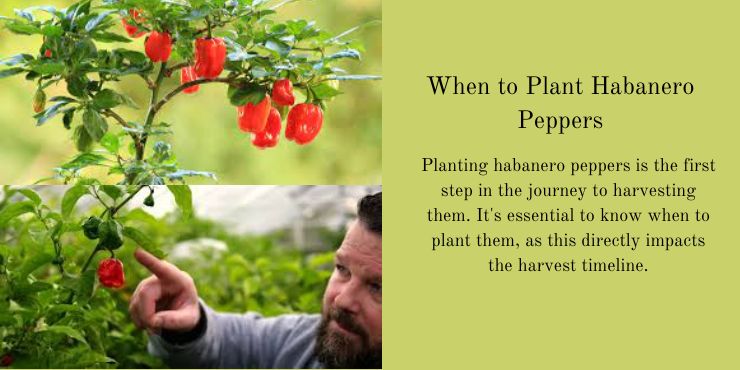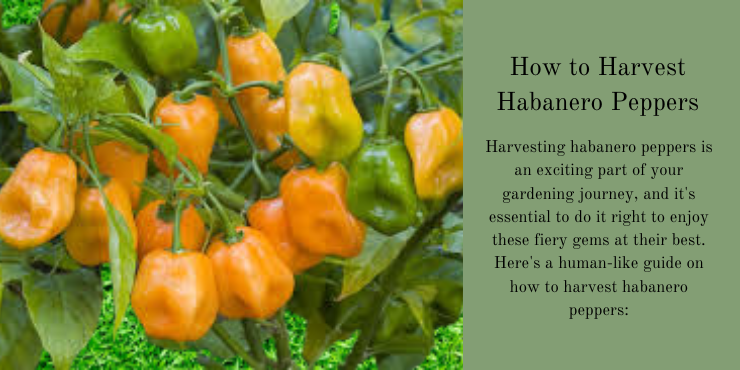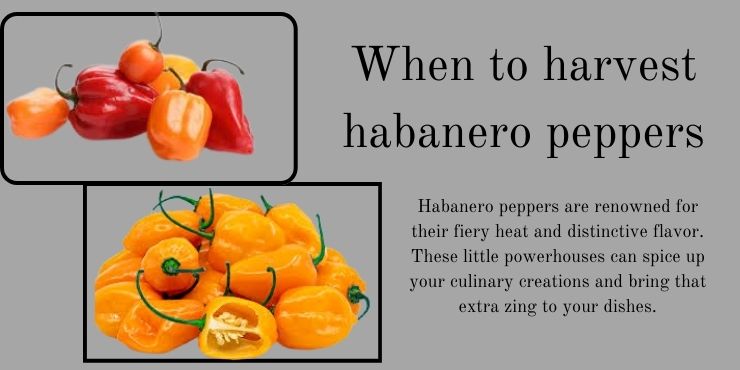Harvest Habanero Peppers
Harvest Habanero Peppers, known for their fiery heat and unique flavor, is a favorite among Habanero peppers are renowned for their fiery heat and distinctive flavor. These little powerhouses can spice up your culinary creations and bring that extra zing to your dishes. However, knowing the perfect time to harvest habanero peppers is crucial to ensure they reach their full potential in both flavor and heat. In this article, we will explore the various stages of habanero pepper growth and guide you on when and how to harvest them to enjoy their fiery goodness.
Understanding Habanero Peppers
Before delving into the harvesting process, let’s get to know habanero peppers a bit better. Habaneros, scientifically known as Capsicum chinense, are native to the Amazon region and are known for their intense heat. They come in various colors, with the most common being orange and red, though they can also be green when unripe.
When to Plant Habanero Peppers

Planting habanero peppers is the first step in the journey to harvesting them. It’s essential to know when to plant them, as this directly impacts the harvest timeline. Habanero peppers are typically grown from seeds, and they thrive in warm climates. Plant them indoors 8-12 weeks before the last expected frost date in your region.
The Growth Stages
The growth stages of habanero peppers are a fascinating journey that begins with planting and culminates in the harvest of these fiery little fruits. Understanding these stages is crucial for nurturing your habanero pepper plants to their full potential. Let’s explore the growth stages in detail:
- Germination: The habanero pepper’s life starts as a tiny seed. To kickstart germination, plant the seeds in well-draining soil and ensure they are kept in a warm, moist environment. Typically, habanero pepper seeds will take about 7-10 days to sprout and emerge as seedlings.
- Seedling Stage: Once the seeds have sprouted, they enter the seedling stage. At this point, they are fragile and need plenty of sunlight to thrive. It’s common to keep them indoors during this phase to protect them from external factors that may harm their growth.
- Transplanting: After the threat of frost has passed, it’s time to transplant your habanero seedlings into the garden or larger containers. They should have a sturdy root system by now, which allows them to withstand the challenges of the outdoors.
- Maturation: This is the most critical stage for habanero peppers, where they transition from small plants into mature pepper-bearing ones. As the plants grow, they produce flowers which eventually turn into peppers. It’s essential to be patient during this stage and allow the peppers to ripen properly.
Each of these growth stages is a significant step in the journey to a bountiful habanero pepper harvest, and understanding them will help you nurture your plants successfully.
The Best Time for Harvest
The best time to harvest habanero peppers is when they have reached their mature color, whether that’s orange, red, or any other desired hue. The peppers should be firm, and their skins should be smooth. Be prepared for some heat when handling these fiery little fruits, and it’s advisable to wear gloves while harvesting.
Harvesting Tools and Preparation
Before you embark on your habanero pepper harvesting adventure, it’s essential to gather the following tools and make some necessary preparations:
- Gardening Gloves: Habanero peppers are renowned for their intense heat, and this trait extends to their skin. To protect your hands from the fiery capsaicin that habaneros contain, it’s highly recommended to wear gardening gloves. These gloves shield your skin from potential irritation and ensure a more comfortable harvesting experience.
- Scissors or Pruning Shears: To harvest habanero peppers with precision and care, you’ll want to have a pair of sharp scissors or pruning shears on hand. These tools make it easier to snip the peppers from the plant without causing damage to the stems or the plant itself. They’re especially useful if your habanero peppers are growing close together, as they allow you to navigate the tight spaces more effectively.
- Container: To collect the freshly harvested habanero peppers, have a container ready. A basket, a bucket, or a large bowl works well. Choose a container that’s spacious enough to accommodate your harvest without squishing the peppers.
- Timing: Timing is crucial for a successful habanero pepper harvest. Make sure you pick your peppers during the right time of day. Early morning, when the temperatures are cooler, is an ideal time to harvest habaneros. This minimizes the risk of sunscald and helps retain the peppers’ best flavor and heat.
- Wear Protective Clothing: In addition to wearing gloves, consider wearing long sleeves and pants to protect your arms and legs from any potential contact with capsaicin. It’s also advisable to avoid touching your face while harvesting habaneros to prevent any accidental irritation.
By having these tools and taking these precautions, you’ll be well-prepared to harvest your habanero peppers efficiently and without any unwanted discomfort. Remember that safety and precision are key when collecting these fiery little fruits.
How to Harvest Habanero Peppers

Harvesting habanero peppers is an exciting part of your gardening journey, and it’s essential to do it right to enjoy these fiery gems at their best. Here’s a human-like guide on how to harvest habanero peppers:
- Wear Protective Gear: Before you begin, put on your gardening gloves. Habanero peppers are known for their extreme heat due to capsaicin, and wearing gloves is essential to protect your hands from potential irritation. Additionally, consider wearing long sleeves and pants to shield your skin from contact with capsaicin.
- Choose the Right Time: Timing is critical. Harvest your habanero peppers when they’ve reached their mature color, be it orange, red, or any other hue you desire. The peppers should be firm to the touch, and their skins should appear smooth. This is the stage when habaneros are at their spiciest and most flavorful.
- Gather Your Tools: Prepare your scissors or pruning shears. These tools make the process more precise and help avoid damage to the plant. Get a container ready to collect the harvested peppers, ensuring it’s spacious enough to hold your entire harvest without crushing the peppers.
- Pick by Hand: One method of harvesting habanero peppers is to use your hands. With gloves on, gently twist each ripe pepper from the plant. Be careful not to damage the stems or the plant itself. This method is ideal if you have only a few peppers to harvest or if they are growing individually.
- Use Scissors or Pruning Shears: For a more precise approach, you can use scissors or pruning shears. Snip the peppers from the plant, cutting the stems just above the pepper itself. This method is particularly useful if you have a densely populated habanero plant with peppers growing close together.
- Handle with Care: Regardless of the method you choose, handle the habanero peppers with care. Avoid squeezing or crushing them to prevent damage. The capsaicin can irritate your skin or eyes, so be cautious not to touch your face while harvesting.
- Inspect for Damaged Peppers: After harvesting, take a moment to inspect the peppers. Remove any that are damaged, bruised, or diseased. This will help prevent issues with the rest of your harvest and ensure that you collect only the best peppers.
- Wash the Peppers: Before using the habanero peppers in your culinary creations, give them a gentle wash under cold running water. This removes any dirt or residue from the harvesting process.
Following these steps will allow you to harvest habanero peppers safely and effectively, ensuring you get the most out of their fiery flavor and heat. Enjoy incorporating these spicy gems into your favorite recipes!
Conclusion
Harvesting habanero peppers is a rewarding process that allows you to enjoy their intense heat and flavor. By following the guidelines outlined in this article, you’ll be able to pick these fiery gems at the peak of their ripeness and incorporate them into your culinary creations.
FAQs
- Can I eat habanero peppers when they’re green?
Yes, you can eat habanero peppers when they’re green, but they will be milder in flavor and heat compared to their ripe, colorful counterparts.
- What are the common uses for habanero peppers?
Habanero peppers are often used to add spiciness and flavor to various dishes, including salsas, hot sauces, marinades, and even as a garnish for some cocktails.
- How spicy are habanero peppers?
Habanero peppers are known for their extreme spiciness, ranging from 100,000 to 350,000 Scoville Heat Units (SHU). They are significantly hotter than jalapeños.
- Are habanero peppers easy to grow?
Habanero peppers can be grown successfully by novice gardeners, but they do require some attention to detail, especially in terms of temperature and moisture.
- Can habanero peppers be frozen?
Yes, habanero peppers


